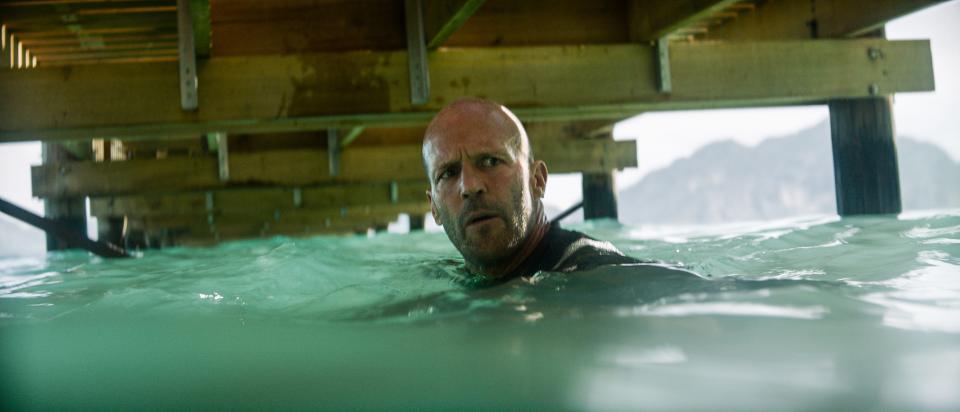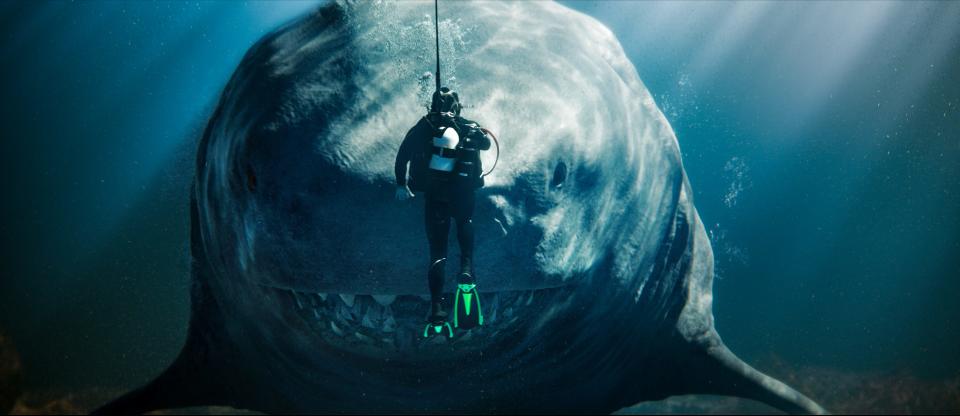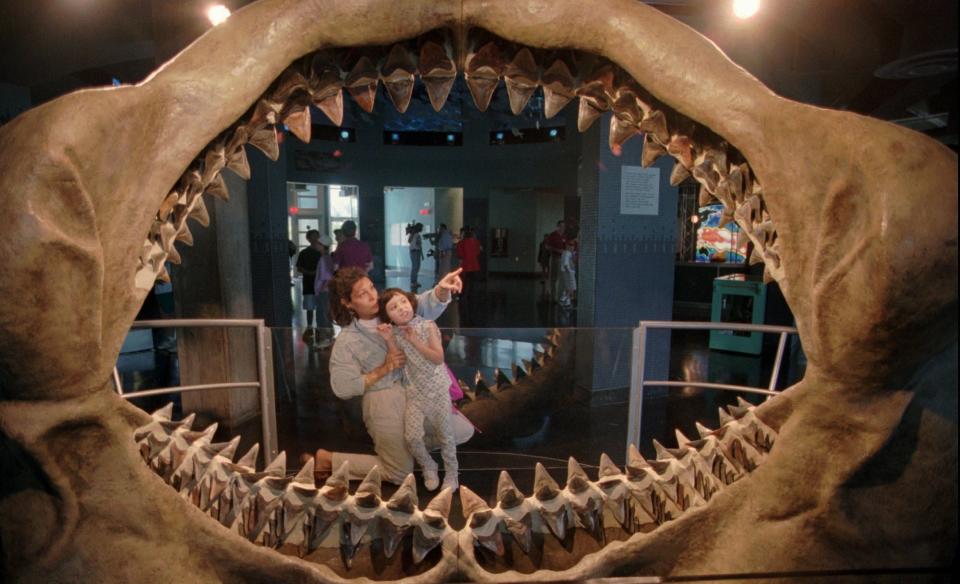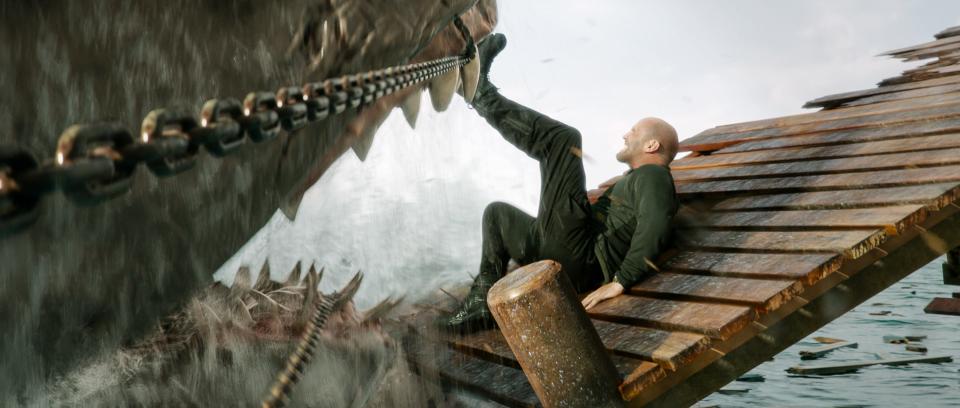Meet the megalodon: What you need to know about the shark star of 'Meg 2: The Trench'
- Oops!Something went wrong.Please try again later.
- Oops!Something went wrong.Please try again later.
Since Steven Spielberg's “Jaws” in 1975, sharks have boasted a serious pop culture bite. But when it comes to dealing with a trendier toothy menace ... well, we’re going to need a bigger boat.
Great whites have had a good run at the movies for decades, starring in cinematic adventures both admirable (“The Shallows”) and abhorrent (“Shark Exorcist,” anyone?), so it’s time for some fresh meat. “The Meg” films – including the new sequel “Meg 2: The Trench” (streaming on Max and available to buy/rent on Apple TV and other on-demand platforms) – and the recent sea thriller “The Black Demon” put the spotlight on the megalodon, a prehistoric shark species that measured 50 to 60 feet long and weighed around 50 tons. That’s more than three times the size of a modern great white.
The appeal comes down to fear factor: “Let's say you're in a boat and a 15-foot great white swims by and then a 60-foot megalodon swims by. Which one's going to scare you more?” asks Steve Alten, whose 1997 book “Meg: A Novel of Deep Terror” was the basis for the “Meg” film franchise. “Bigger is better, especially when bigger can eat you whole as opposed to taking bites out of you.”
Here’s what you need to know about the fin-tastically fishy predator trying to eat Jason Statham:
‘Meg 2’ triples the chomp for star Jason Statham

In the first “Meg,” rescue diver Jonas Taylor (Statham) and scientists at an underwater research facility fight for survival when the largest shark to have ever lived emerges from a deep section of the Mariana Trench and wreaks havoc on a crowded beach.
The sequel, directed by Ben Wheatley (“Kill List”), ratchets up the danger when Jonas and Co. have to deal with not one but three megalodons that hunt in a pack, plus other ginormous sea creatures from the trench.
"As a shark movie fan, you are already humble because of 'Jaws.' 'Jaws' is not just the best shark film, it's the best film," says Wheatley, who got a kick out of doing a "poppy and fun" movie. "I'd been on a mission for years of trying to make a movie that wasn't really cynical and depressing."
Megalodons co-existed with great whites, not dinosaurs

The “Meg 2” trailer features a meg chewing on a T. rex, but in reality, dinos went extinct 65 million years ago and the meg came to be 23 million to 26 million years ago. Unlike other animals where paleontologists can study whole skeletons and trackways, megalodon has been difficult because sharks don't have bones (their skeletons are primarily cartilage) and “all we had was their teeth,” says Sora Kim, an associate professor of paleoecology at the University of California, Merced. She uses stable isotope analysis to study the chemistry of teeth, muscle tissue and blood to compare and contrast modern and fossil animals.
Kim says megalodons lived in an ocean world with “a lot more diversity of marine mammals” – including whales, toothed and untoothed – plus great white sharks, and researchers have found “pretty shocking” evidence that some megalodons swam high up on the food chain while others were fairly low. “There was a lot of variation in meg diet, which is similar to white sharks. In white sharks, there is evidence of specialists as picky eaters and generalists that are opportunists.”
'Jaws' vs 'The Meg': A definitive ranking of the best shark movies
Unfortunately, size did matter for the megalodon

One major reason why the meg went extinct around 3 million years ago: It was just too darn big. While being an apex predator might sound good, “it's really hard to keep up with that level of (food) consumption,” says Kim, who was part of a recent study that determined megalodons, like modern great whites, were endothermic creatures. “If they’re warm-blooded, then they even need more food, more calories to keep up that metabolic rate.”
The physiological issues were compounded by ecological ones. The megalodons died out at “a time when ocean conditions were changing with climate change affecting prey distribution and availability,” Kim adds.
"The story of them is really sad, isn't it? It would make for quite the depressing film," Wheatley says. But "Meg 2" leans into "a lot of movie science, so you can't take it too seriously. It's not a National Geographic lesson."
Nobody should be worried about a megalodon attack

Alten gets asked a lot if megalodons might still exist somewhere and while he won’t totally disqualify the idea (“Only 5% of our oceans have been explored, less than 1% of the deep, so we have no idea what's down there”), scientists are pretty sure they're extinct.
Were they to exist, Statham and the rest of us would probably be OK. Kim thinks they’d exhibit similar behavior to a really large Orca.
“Just because something has huge teeth doesn't necessarily make it as intense and scary as what's been portrayed in Hollywood,” she says. “Humans have put these personalities on sharks, but in reality, they're just doing their thing.”
But no matter the size, sharks deserve our respect
Nearly 50 years after “Jaws” scared people off the beach, the public still has a massive interest in sharks – “Shark Week” is a thing for a reason. But in recent years, there’s been more of an outcry from activists fighting for their conservation. “Sharks are not the enemy,” says Alten, who just started writing his final “Meg” novel. “Killing millions of them is hurting ourselves. We're the problem, not the sharks.”
The fact that an extinct shark is at the heart of his movie "allows me to sleep at night," Wheatley says with a laugh. "No one's going to be going out murdering a load of megalodons because of our film, that's for sure. We can get back into the psychology of these big monster movies and why people like them."
And Kim feels that a fictional action adventure where a megalodon fights a Hollywood action hero can be a net positive.
“It's great that they’re bringing an animal and ecology into people's lives, even though it's like totally not realistic," she says. "Maybe we can use this to help get people excited for sharks and science.”
'Jaws' vs 'The Meg': A definitive ranking of the best shark movies to celebrate Shark Week
This article originally appeared on USA TODAY: 'Meg 2: The Trench': Why the megalodon deserves its shark movie moment

